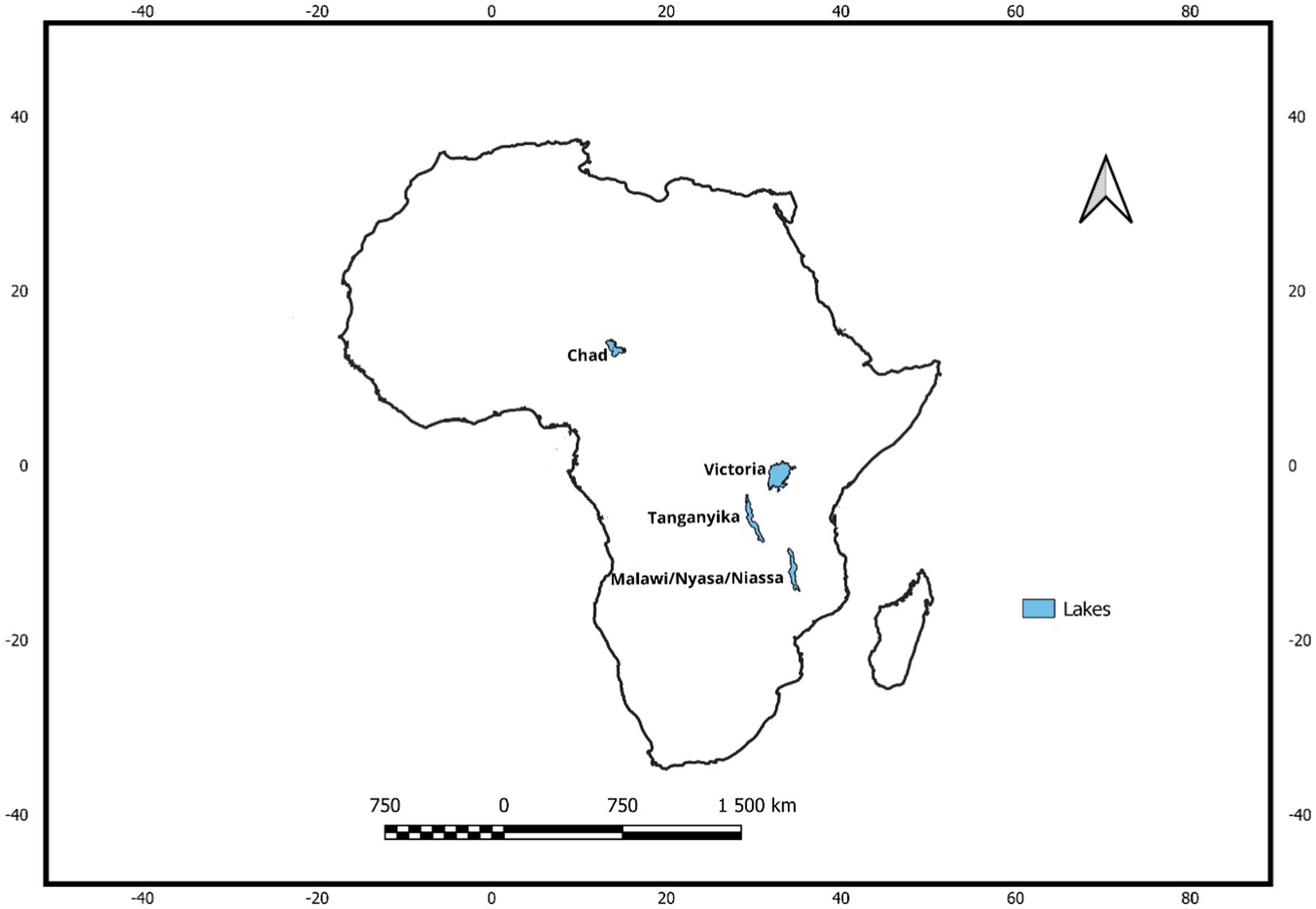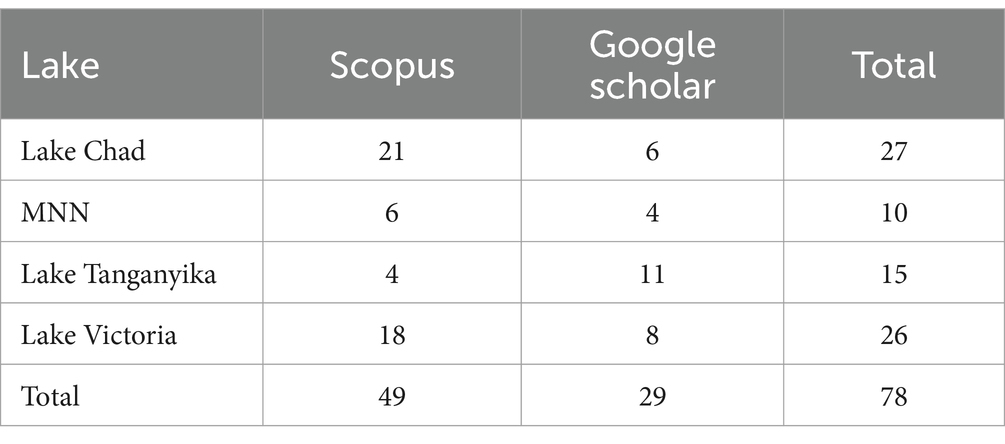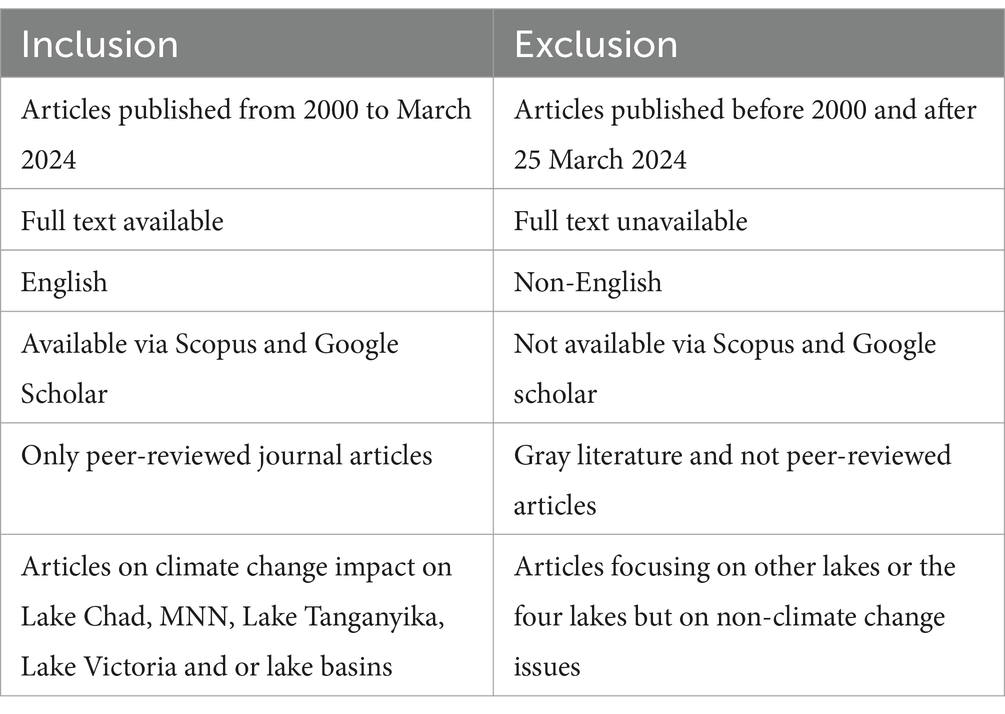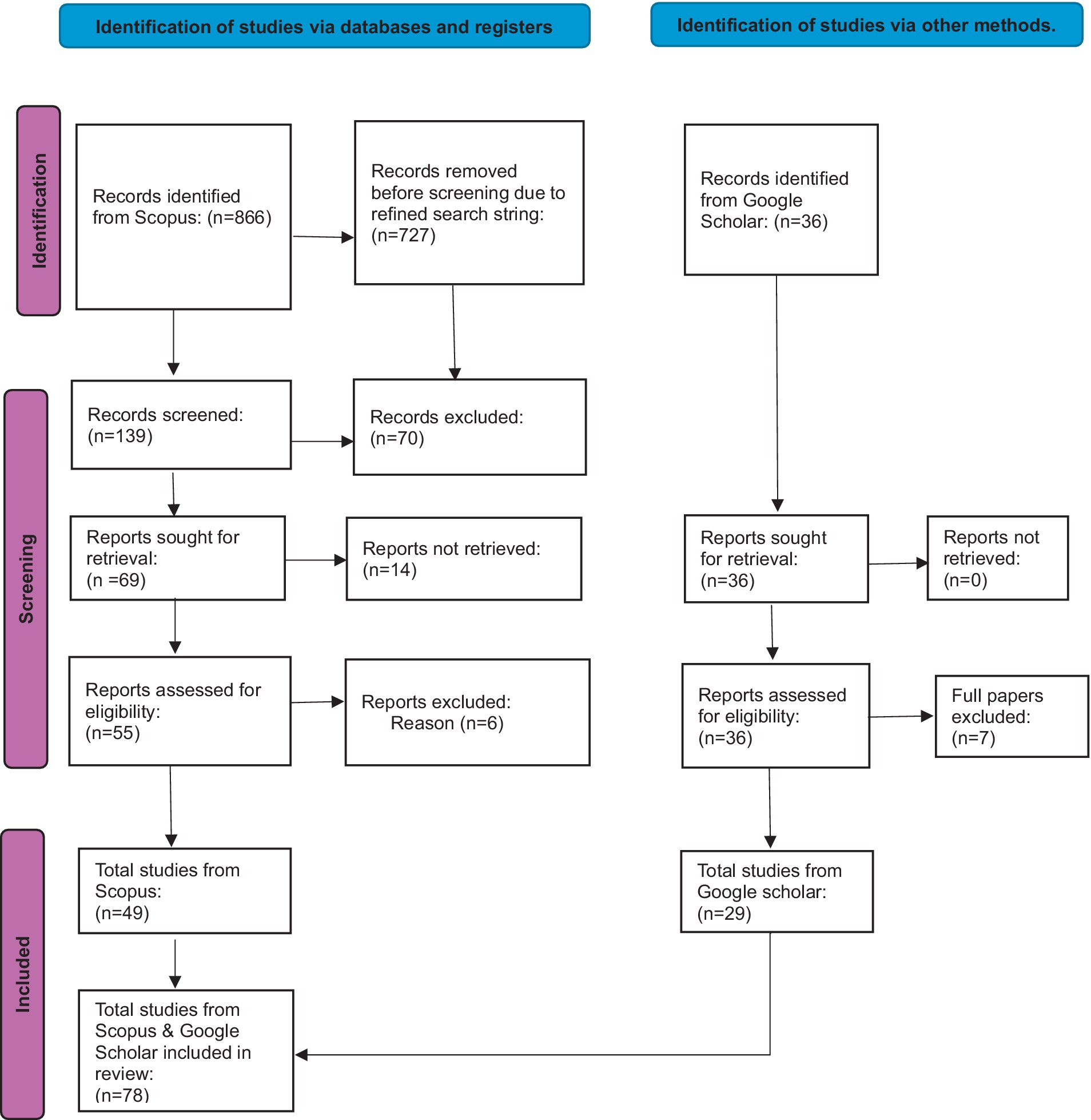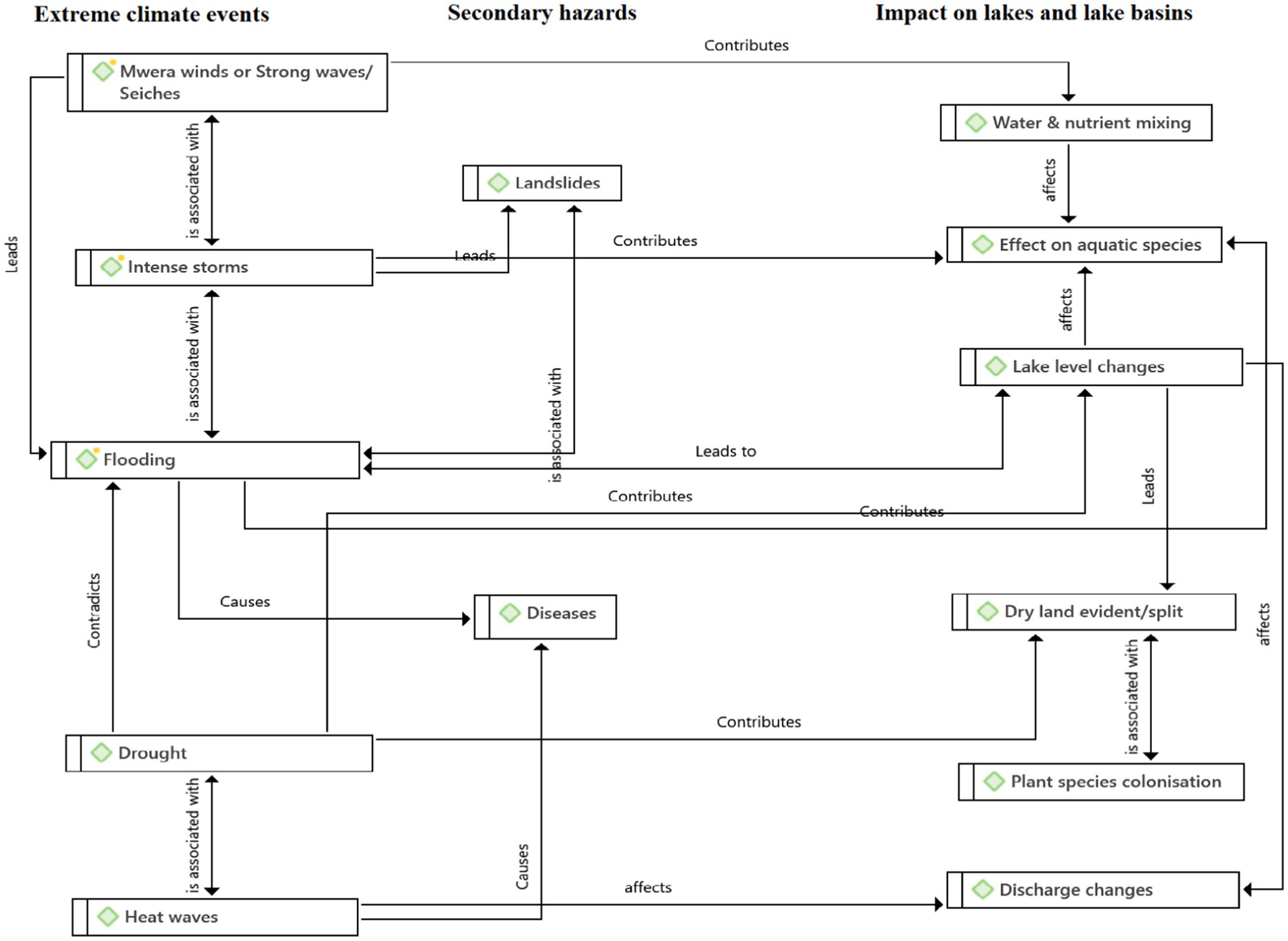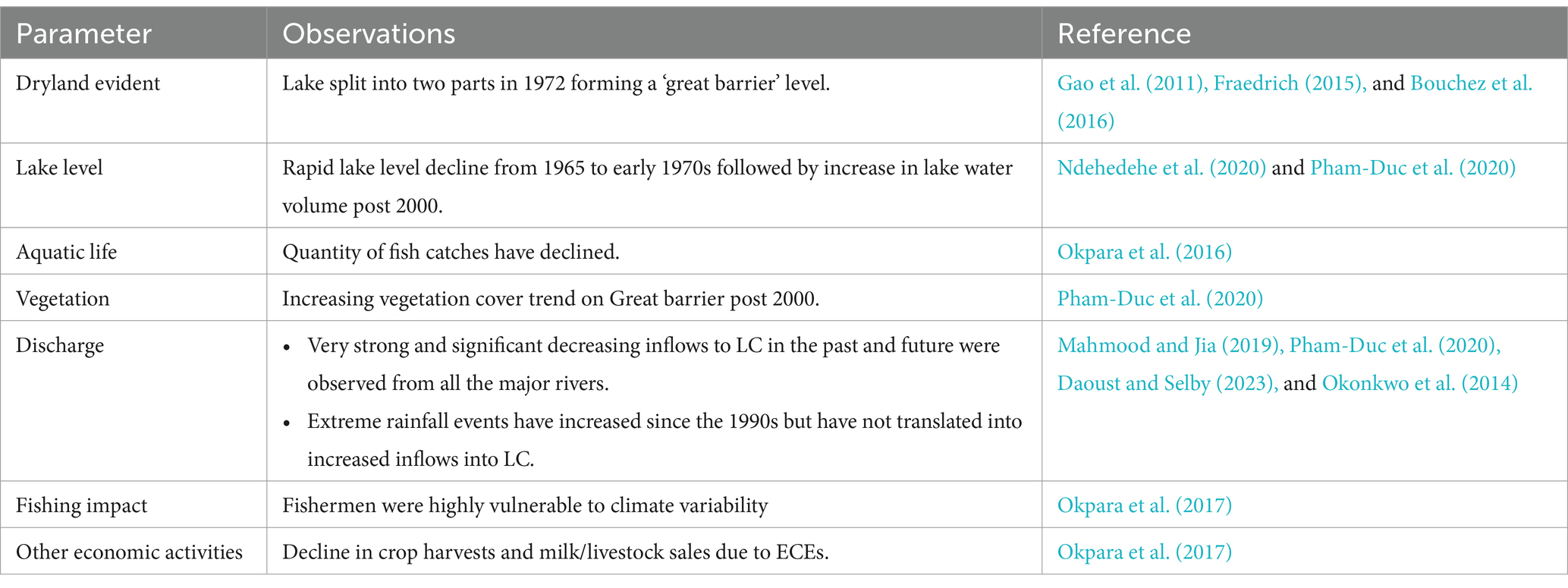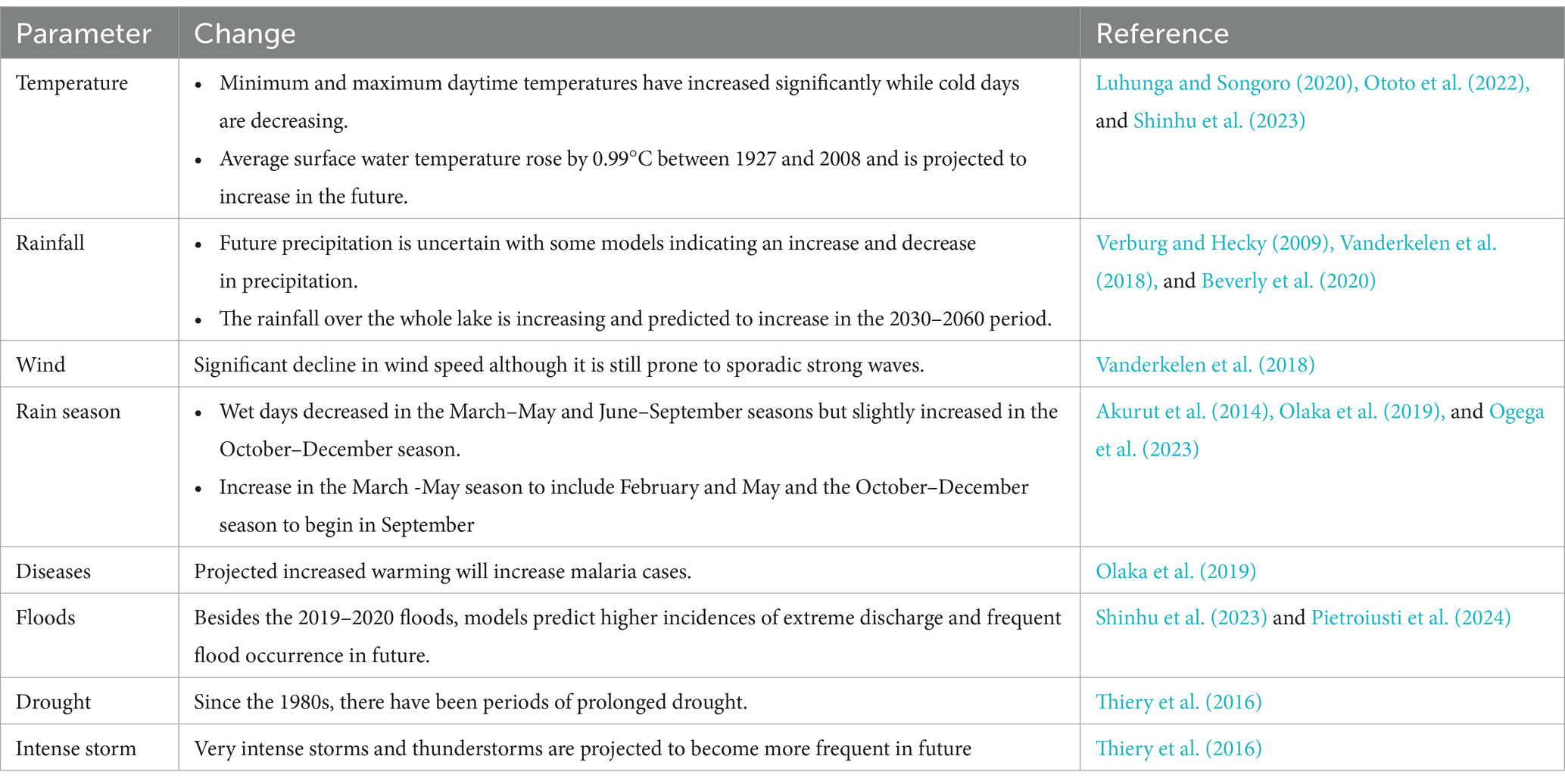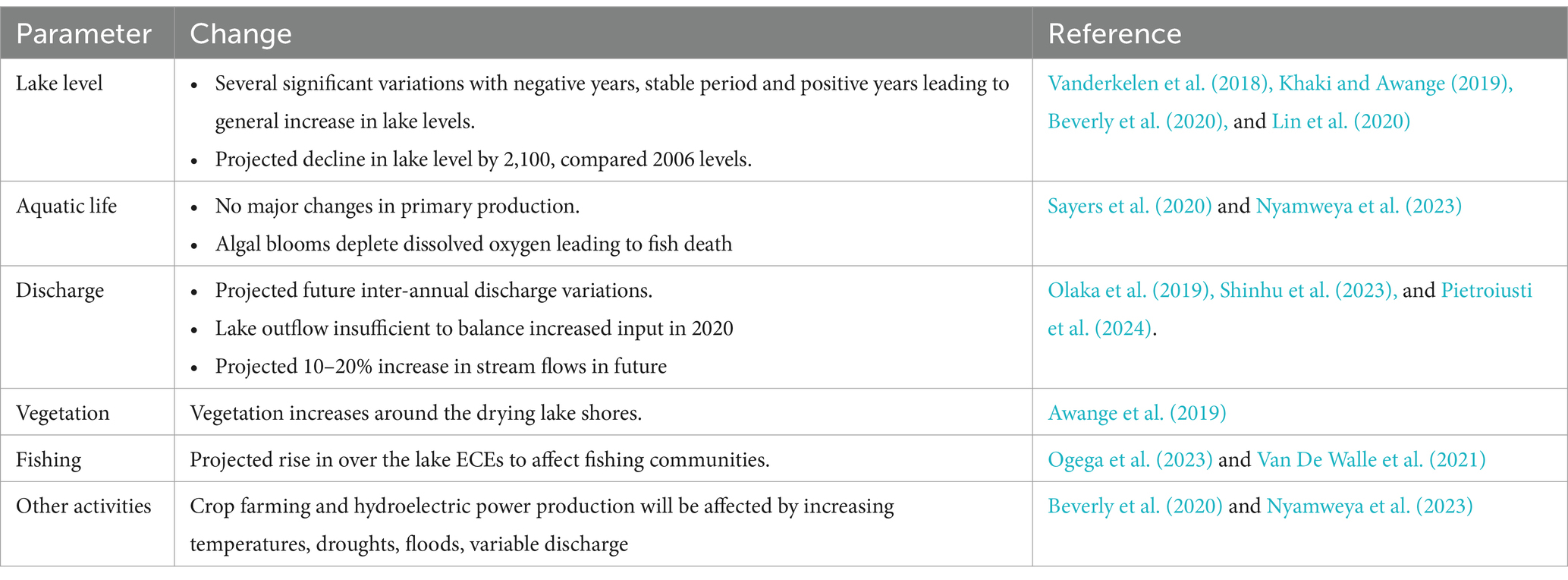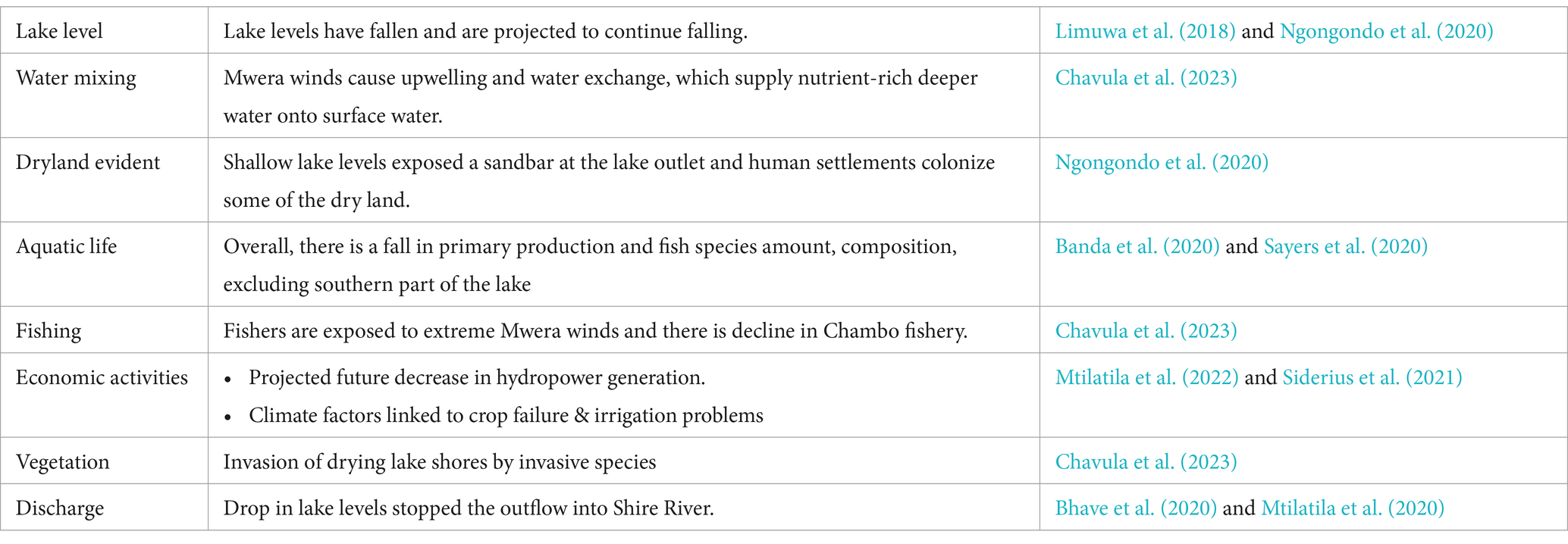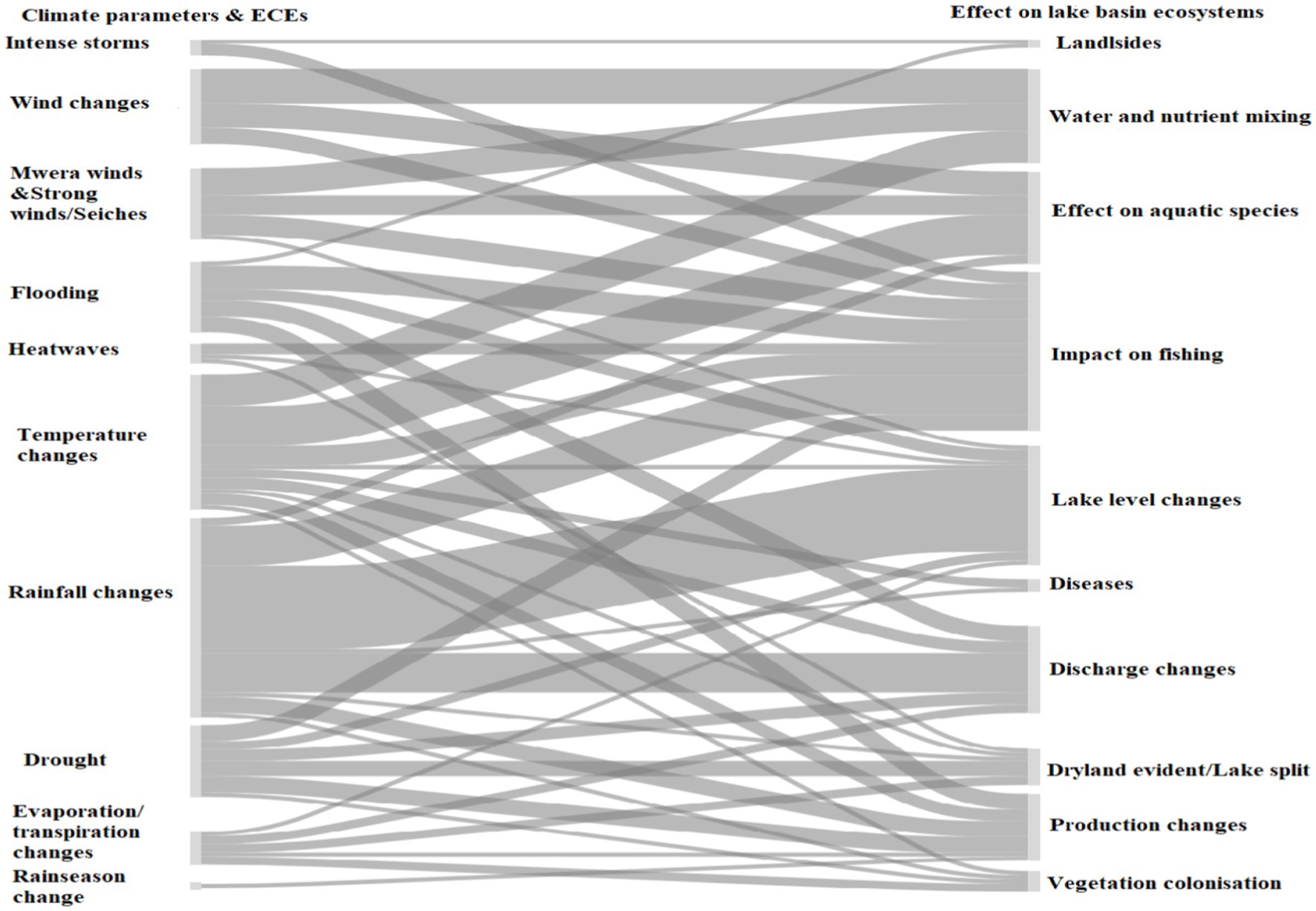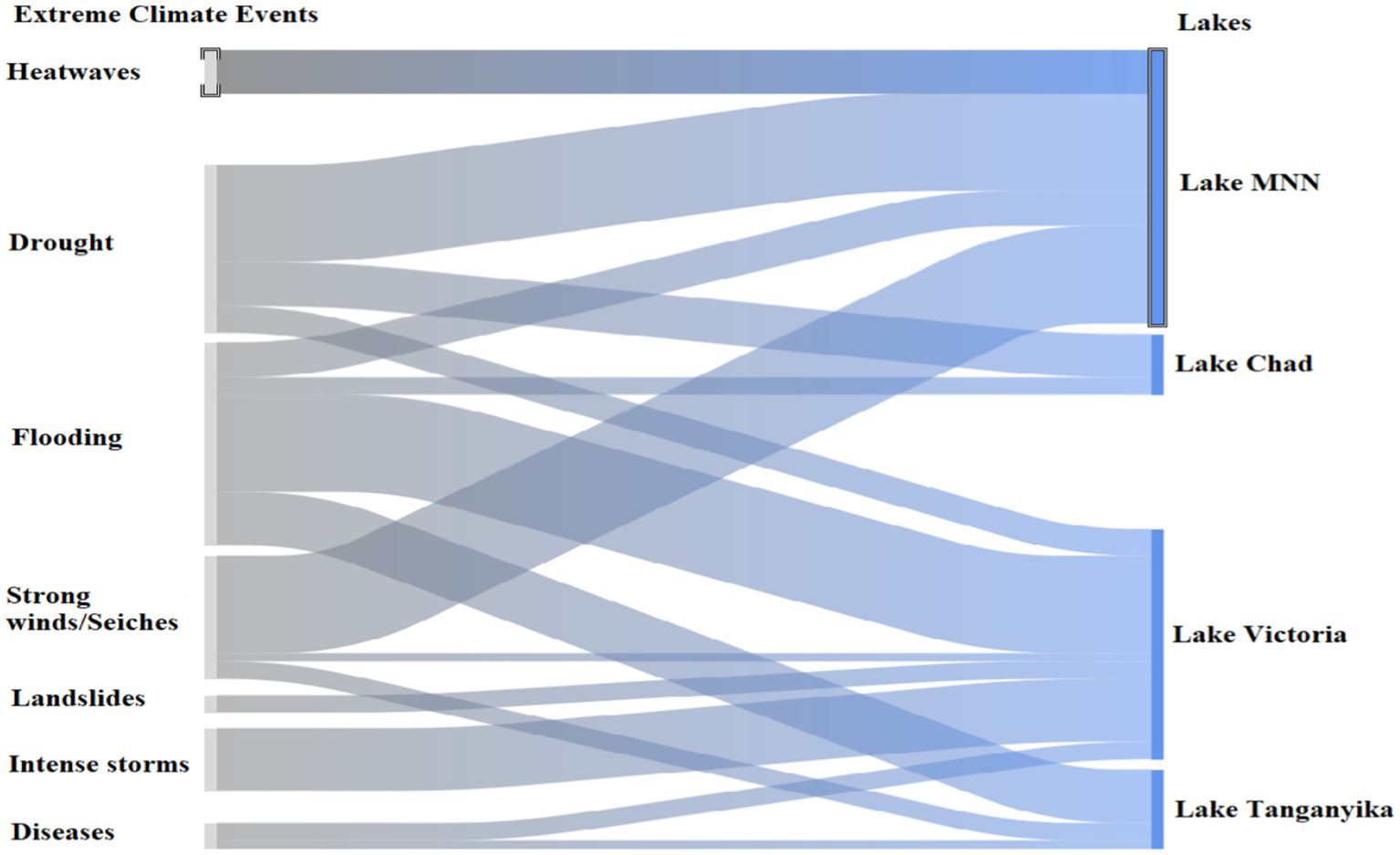- Exxaro Chair in Climate and Sustainability Transitions, Institute for Corporate Citizenship, University of South Africa, Pretoria, South Africa
Climate change is a global phenomenon with profound effects on ecosystems, including lakes, which are an important source of fresh water, fisheries, and biodiversity conservation. Africa, with its limited freshwater resources, remains vulnerable to climate change impacts. This study systematically reviews the literature to understand the impact of climate change on four major African lakes (Chad, Victoria, Tanganyika, and Malawi/Nyasa/Niassa) and to identify pathways for enhancing their resilience and society’s dependent on them. The review was conducted in accordance with the Preferred Reporting Items for Systematic Reviews and Meta Analyses (PRISMA) 2020 guideline using journal articles extracted from the Scopus and Google Scholar databases and analysed using ATLAS.ti 24 software. The study found that climate change and extreme climate events (ECEs) are disproportionately affecting the physical, chemical, and biological characteristics of the lakes, leading to changes in lake levels, aquatic life, nutrient mixing, and the provision of ecosystem services. This result in far-reaching implications for the socioeconomic activities and livelihoods that depend on these water bodies. While some lake associations are taking measures to enhance lakes’ resilience to climate change, a lot more needs to be done. To enhance the climate resilience of African lakes and societies, lake associations are encouraged to implement watershed and water level management, invasive species management practices and enforcement of buffer zones around lakes. There is also a need for community engagement and education on climate-resilient practices, development of ECEs early warning systems and agricultural adaptation if lake dependent communities are to be climate-resilient.
Systematic review registration: https://www.prisma-statement.org/.
1 Introduction
Climate change is causing complex reactions in ecosystems that are both natural and human-made worldwide (Orke and Li, 2022; Woolway et al., 2022). One of the areas most impacted is water resources (Mtilatila et al., 2022). Most of the world’s water, approximately 97% by volume, is held in the oceans as saltwater, and the remaining 3% is freshwater, of which slightly more than two-thirds are frozen in glaciers and polar ice caps (Mtilatila et al., 2020). The remaining freshwater is primarily found as ground water (30%), with only a small portion currently found above the ground (0.9%) (Nyembo et al., 2021). Freshwater availability is uncertain going forward due to anthropogenic variables such as population expansion, water pollution, economic development, and changes in land use (Yunana et al., 2017; Peter et al., 2020; Wubneh et al., 2022).
Although the aforementioned factors are causing a decrease in the fraction of freshwater, the dangers to freshwater are multiplied by climate change (Woolway et al., 2020) as it has emerged as the biggest threat to the world’s lake ecosystems. Lake ecosystems store around 87% of the planet’s liquid surface freshwater and offer a variety of ecosystem services, including fisheries and water supply (Woolway et al., 2020). As such, they are covered by the Sustainable Development Goals (SDGs) of the United Nations, which are devoted to water resources (Goal 6.6) and other SGDs related to environmental dimensions (Goals 13, 14, and 15) (Ho and Goethals, 2019; Woolway et al., 2022). Undoubtedly, global climate change has impacted lake ecosystems, and it is anticipated that the long-term trends of change noted in the last few decades will not only persist, but in many cases, get worse soon (Woolway et al., 2022). With ongoing global warming and amplified climatic teleconnections, the ecological reactions of lakes to climate change will intensify in the future (Havens et al., 2016). Numerous studies indicate that lakes are sensitive to changes in the climate and that these changes have a quick impact on the physical, chemical, and biological characteristics of lakes (Adrian et al., 2009). Lakes are efficient sentinels, integrators, and regulators of climate change (Adrian et al., 2009; Williamson et al., 2009; Råman et al., 2021).
Lakes in their normal state are important climate change regulators because they store carbon from the nearby terrestrial watershed, exchange greenhouse gases (GHGs) with the surrounding atmosphere and modify local climates (Williamson et al., 2009; Peter et al., 2020). Lakes store signals of change in aquatic, surrounding terrestrial ecosystems, and airsheds in their sediments. Hence, they are integrators of climate change information that allow paleo-limnologists to record changes over historical periods (Williamson et al., 2009). Lakes respond very quickly to changes in precipitation, and a range of atmospheric inputs, making them sentinels of contemporary climate change signals in addition to being integrators of historical climate data in their sediments (Williamson et al., 2009). Additionally, lakes can act as sentinels and environmental sensors in a variety of climatic regions as they capture different aspects of climate change, such as rising temperatures, glacier retreats, and melting permafrost. This is because lake ecosystems are distributed worldwide and in warm and cold regions (Adrian et al., 2009; Zhang and Duan, 2021).
According to Smith et al. (2005) around 175 lakes completely disappeared in the Arctic lakes due to the thawing of permafrost and shores have been vegetated despite slight increases in precipitation in the area. This decline in lake abundance and surface area is thought to have been caused by the warming of the Arctic, as evidenced by the 11% decline between 1973 and 1998 (Smith et al., 2005). However, Shugar et al. (2020) present contradictory findings, revealing that glacial lakes are expanding quickly in response to climate change and glacier retreat, resulting in the formation of supra-glacial, moraine-dammed, and ice-marginal lakes. However, as warmer winters and longer periods without snow expose lake surfaces to Arctic lake drying and water loss through evapotranspiration, northern tundra locations have seen a decline in the number of lakes by 21% and area of lakes by 2%, leading to the revegetation of shrinking lakes (Finger et al., 2019). Climate warming is eliminating the physical barrier (winter ice cover) between the lake surface and the atmosphere, and this is impacting on water availability since evaporation is rising significantly (Woolway et al., 2022).
Tropical climates, like those in Africa with chronic water shortages have not been spared from the effects of climate change on water resources, lakes included (Mtilatila et al., 2022). Out of the 43,802 km3 global freshwater resources, Africa accounts for 9% of this volume, falling behind Asia (28.3%) and South America (15.7%) (Yunana et al., 2017). While polar and alpine locations are expected to see the worst effects of climate change, tropical lakes in Africa are significantly warming since the minimum temperature has risen more quickly than the maximum temperature (Williamson et al., 2009; Muringai et al., 2022). The inherent water scarcity in Africa is further worsened by already-existing non-climatic stressors, the continent’s high susceptibility to climate change due to its warm climate, and a greater proportion of its people reliant on lake supplies.
The possible effects of climate change on lakes, particularly in Africa, are concerning because lakes are shared hydrologic units among member states and their degradation in the context of the continent’s chronic water scarcity and rising freshwater demand has socioeconomic, hydro-political, and geopolitical ramifications (Asah, 2015; Roth et al., 2018). The increasing impact of climate change on Africa’s water resources made the Africa Water Vision for 2025 and the New Partnership for Africa’s Development to call for new ways to support countries in integrating climate change responses into their national development processes (Faramarzi et al., 2013). The understanding of water storage changes within the lake basins and the related impacts of climate variability is an essential step in managing its water resources (Awange et al., 2013, 2014).
Lakes are important sentinels of climate change by virtue of being very sensitive to environmental changes and being distributed in many different geographic locations and climatic regions, capturing different aspects of climate change (Adrian et al., 2009; Zhang and Duan, 2021). It is crucial to identify alterations in earth surface characteristics, such as lakes, to understand the connections between natural and human-driven changes (like climate change) phenomena and to better manage increasingly scarce natural resources (Nsubuga et al., 2017). According to Ngoran et al. (2015), increasing awareness of the African-climate change-water resources (lakes in particular) interconnection will provide insight to proactively address chronic water insecurity on the continent and open the door to sustainable management of water resource (lakes included).
Havens and Jeppesen (2018) call for contemporary researchers to document how lakes around the world are changing in response to climate change and to provide insight into the growing body of knowledge about expected future changes. Lake variables are therefore considered essential climate variables, i.e., variables that critically contribute to the characterization of the earth’s climate (Woolway et al., 2022). Although it is generally agreed upon that lakes can serve as sentinels of climate change, the effectiveness of these roles has not been fully investigated; as such, a more detailed examination of the possibility of lakes serving as information signals for climate change is required (Adrian et al., 2009). Moreover, research on the reactions of different lake ecosystems to climate change have generally been studied in isolation (Woolway et al., 2022).
Given the foregoing, this work seeks to conduct a comprehensive literature review of studies on the African-climate change-lake resources interconnection. Therefore, the study answers two research questions: (i) What are the key emerging impacts of climate and weather-induced change on Africa’s major lakes? (ii) What are the potential future pathways for enhancing climate resilience of lake ecosystems?
2 Materials and methods
2.1 Study area
The four study lakes (Figure 1) are Lake Chad, Victoria, Tanganyika, and Lake Malawi/Nyasa/Niasa (LMNN). Lake Chad is one of the world’s most important agricultural heritage sites, providing a lifeline to nearly 30 million people in four riparian countries (Cameroun, Chad, Niger, and Nigeria) in West Africa. There are reports of it having experienced a significant decline in lake surface from 50,000 BC up to present (Yunana et al., 2017). LMNN is the fifth or ninth largest freshwater lake in the world (by volume/surface area), and it is an example of a vital water resource for hydropower generation yet a vulnerable hydro-system in the tropics (Mtilatila et al., 2020). LMNN is a shared water resource between Malawi, Mozambique and Tanzania.
Lake Tanganyika is a meromictic lake, second largest lake (by area) in Africa located in East Africa with a maximum depth of 1,470 m, and the second oldest and deepest lake in the world (Verburg and Hecky, 2009; Naithani et al., 2011). It is a shared water resource between Burundi, the Democratic Republic of Congo (DRC), Tanzania and Zambia. The lake is surrounded by poor countries whose inhabitants strongly depend on this resource for their basic needs such as intensive fishery (Sterckx et al., 2023). Although Lake Tanganyika is undergoing significant changes because of the climate change, it is unknown how these changes may affect the lacustrine system’s ability to function in the future (Sterckx et al., 2023). Climate change is also affecting Lake Victoria, the biggest and second largest freshwater lake in Africa and earth, respectively. It is also an important source of livelihoods for more than 30 million people living in three riparian countries (Tanzania, Kenya and Uganda) and indirectly supports another 340 million people along the Nile Basin being the source of the White Nile (Awange et al., 2013).
2.2 Keywords and database
This review was conducted in line with the PRISMA guidelines. The PRISMA framework ensures a methodical and repeatable approach to the identification, screening, eligibility evaluation, and extraction of data from literature (Odoi-Yorke, 2024). Peer reviewed journal articles published between 2000 and March 25, 2024, were extracted from the Scopus as main database and Google scholar as a top-up database for systematic review. Scopus was chosen as the primary database because it is a broad abstracting and indexing database that facilitates access to a wide range of international publications, guaranteeing comprehensive worldwide coverage of research findings from various geographic locations (Odoi-Yorke, 2024). Additionally, Web of Science papers are indexed in Scopus. Key words such as ‘lake names’, ‘climate change’, ‘climate variability’, ‘ECEs’ were used to extract relevant journal articles from the two databases (Table 1).
2.3 Inclusion and exclusion criteria
A generic and refined search from Scopus database was done and it yielded 866. This was followed by a refined search protocol that yielded 139 articles considered for manual abstract screening. Both search protocols are presented herein.
TITLE-ABS-KEY ((“Climate Change” OR “Climate variability” OR “Climate extremes” OR “global warming”) AND (lake*) AND (africa)).
TITLE-ABS-KEY ((“Climate Change” OR “Climate variability” OR “Climate extremes” OR “global warming”) AND (lake AND chad) OR (lake AND victoria) OR (lake AND malawi) OR (lake AND tanganyika) OR (lake AND niasa) OR (lake AND nyasa)) AND PUBYEAR >2000 AND PUBYEAR <2025 AND (LIMIT-TO (SRCTYPE, “j”)) AND (LIMIT-TO (OA, “all”)) AND (LIMIT-TO (SUBJAREA, “EART”) OR LIMIT-TO (SUBJAREA, “ENVI”)) AND (LIMIT-TO (DOCTYPE, “ar”)) AND (LIMIT-TO (LANGUAGE, “English”)).
Table 2 further shows details on the exclusion and exclusion criteria that was used. Such criteria included issues like language and period.
2.4 Screening criteria
No duplicate papers were found out of the 139 documents that were extracted from Scopus for abstract screening. Only 70 articles made it to the stage for full paper screening. A total of 69 articles abstracts from Scopus were successfully downloaded. Further screening of the 69 papers was done to exclude articles older than 2000 and a total of 14 papers were removed and 55 were eligible for full paper screening. After full paper screening, 6 articles were found to be irrelevant and 49 were selected for systematic literature review. Top-up articles from Google scholar were also extracted using the aforementioned key words and a total of 29 articles were extracted. Checking for duplicates on articles from Scopus versus Google data database was done and some duplicates were found and those from the former database were excluded, and 29 articles remained for review. A total of 78 articles were used for systematic literature review. Figure 2 shows the PRISMA flow chart from both the abstracts and full documents text screening.
2.5 Data analysis
Using ATLAS. Ti 24 software, data from the literature review was analysed. Themes and/or codes based on the climate parameters, lake parameters, hydrological and economic activity changes were noted. ‘Invivo’ coding was supplemented with emerging codes as some impacts were unique to certain lakes. Generation of quotations and codes was done at the same time. Coding was then followed by grouping the codes into code groups that became the themes for the study. The analysis initially focused on impacts associated with each lake followed by comparative analysis across all the lakes. Network and co-occurrence analysis of the codes was done and then across all lakes.
3 Results and discussion
This section is organized into four sub-sections namely (i) presentation of findings on the semantic relationship between the major themes in the study; (ii) climate change impacts on each of the four lakes; (iii) comparative analysis of climate change impacts across the four lakes; and (iv) future pathways to promote resilience to climate change.
3.1 Network analysis of climate parameters, ECEs and lake responses
Climate change is first evident with a change in the climate parameters of an area. The interaction and/or individual effect of these climate parameters has disproportionate influences on the lakes, especially their size, lake level, nutrient and water mixing, water temperature and lake productivity. Climate change trigger ECEs that implicitly and explicitly affect lake basins. Figure 3 shows some notable ECEs (though they varied by lake) their interactions and how they were affecting the four lake basin ecosystems.
3.2 Climate change and ECEs from Lake Chad Basin
Climate change influence the trajectory of climate parameters, intensity and frequency of ECEs. Table 3 summarizes observed and projected changes in climate parameters and ECEs from Lake Chad and/or its basin. Temperature for Lake Chad Basin, the number and frequency of warm days are expected to increase in the future leading to a decline in cool night frequency, and diurnal temperature from 2016 to 2035.
The lake basin was expected to experience more, and stronger droughts from 2020 to 2040, compared to the 1970s. This will be interspersed with sporadic floods, especially on the lake beds where migrant fishermen from other places have seen an opportunity to build their homes. However, there are contradictory findings on the rainfall trajectory of the basin. There are reports that rainfall levels and extreme rainfall events have been increasing across the basin and the eastern Sahel region since 1990 (Bouchez et al., 2016; Pham-Duc et al., 2020; Daoust and Selby, 2023; Gbetkom et al., 2023). However, Nkiaka et al. (2017a) state that annual and seasonal precipitations reduced with moderate and strong downward trends for modeled and observed precipitation, respectively. This makes it difficult for water resources managers to sustainably manage water resources in the basin in the context of contradictory futureprojections.
Although there are contradictory future projections on the rainfall pattern for Lake Chad Basin, it is indisputable that temperatures and drought intensity are increasing thereby affecting lake’s physical, biological, and chemical parameters. Table 4 shows some climate change induced ecosystem changes and human activities. The 1965 to early 1970s droughts rapidly reduced lake levels and depth leading to the division of the once great lake into two pools and a dryland (Great Barrier) between them. Rainfall variability after the 1965 to 1970 droughts led to the separation of the southern and northern pools as the lake levels lowered (Fraedrich, 2015; Bouchez et al., 2016).
From Table 4 it emerges that the drying of lake-bed and the creation of the ‘Great Barrier’ led to vegetation colonization on dryland (Great Barrier) dividing the two pools. The establishment of permanent vegetation on the barrier is also contributing to increased infiltration and the reduction in runoff from the southern pool to the northern pool through the Great Barrier (Pham-Duc et al., 2020). Okonkwo et al. (2014) reported a negative correlation as witnessed by increasing precipitation in the Lake Chad Basin but decreasing river discharge and lake level. Climate change and human activities caused a 59 and 41% decline in streamflow between 1965 and 1972, respectively, while human activities dominated with 66% between 1973 and 2013 (Mahmood and Jia, 2019).
However, in from other publications, the decrease in lake levels during the 1980s and 1990s, has been attributed mainly to human activities such as land use changes in the basin, water withdrawals for irrigation (Mahmood and Jia, 2019). This implies that climate change just added an additional layer to an already existing problem. Warming of lakes and subsequent decline in lake depth has led to a decline in the quantity of fish in the lake. Warming results in water temperature thresholds being reached for certain species (Abdel-Fattah and Krantzberg, 2014). Since 2000, the lake surface area and water stored in the aquifer beneath the lake has increased due to more favorable rainfall in basin and the western Sahel (Bouchez et al., 2016) dispelling myths that the lake will get extinct in the near future. Fishermen had the greatest vulnerability to climate change compared to farmers and pastoralists due to low fish catches and measures put in place to promote climate resilient fisheries. Crop farmers and pastoralists reported losses in crops and decline in livestock product quality due to droughts and also floods for the former as some migrants had turned drying lake beds into arable land.
3.3 Climate change and ECEs from Lake Victoria Basin
Table 5 shows that minimum, maximum atmospheric, and surface water temperatures have increased while daytime temperatures are becoming warmer and cold days decreasing. This might likely lead to the extension of the malaria belt into the highlands of Lake Victoria Basin. However, scholars such as Luhunga and Songoro (2020) project a non-significant decrease in rainfall, while Beverly et al. (2020), Khaki and Awange (2019), and Pietroiusti et al. (2024) state that future precipitation is uncertain. Shinhu et al. (2023) projects an increase in rainfall over the whole lake for the 2030–2060 period. The uncertainty is not peculiar to precipitation patterns only, but also the length of the growing season as projections point to an increase and reduction in rain season across the basin. There are also projected significant declines in wind speed, gustiness, strong waves assumed to be previously associated with heavy thunderstorms (Van de Walle et al., 2021). Although there is a decline in wind speed and intensity, sporadic cases of thunderstorm-induced strong waves capable of capsizing fisher boats, passenger ferries and goods transport boats are still a problem over the lake (Van de Walle et al., 2021; Table 5). Although the lake has been associated with ECEs such as droughts in the 1980s, future climate projections for the 2030–2060 period point to an increase in intense storms and subsequently flooding of the basin.
Table 6 shows that the dam and Basin has been characterized by significant variations in lake levels, with negative years due climate variability and anthropogenic activities such the expansion of Owen Falls dam and Nalubaale Dams in Uganda and between 2003 and 2007, stable period (2007–2011) and significant increase between 2007 and 2012, 2019–2020 leading to a general slight increase from 2003 and 2020 (Khaki and Awange, 2019; Beverly et al., 2020). Awange et al. (2019) argues that such positive trends dismiss the views by Beverly et al. (2020) of lake level reduction by the end of 21st century, and its disappearance in as little as 3,500 years.
The projected future inter-annual variations in rainfall are positively linked to projected inter-annual discharge variations for 8 out of 9 rivers feeding the Lake Victoria Basin from 2015 to 2100. Scholars also observed no major changes in primary production except an increase in algal blooms, which deplete dissolved oxygen when they die leading to deaths of fish in the lake. Such sporadic strong waves, intense storms and over-lake thunderstorms affect water-based activities including fishing as these may lead to boats capsizing (Thiery et al., 2016; Van de Walle et al., 2021; Nyamweya et al., 2023; Ogega et al., 2023). However, future projections in temperature show increased atmospheric and uncertain rainfall patterns, which will affect rain-fed crop and irrigation farming through water shortages and high rates of evapotranspiration.
River discharge is also projected to display inter-annual variations, which has the potential to affect the generation of hydro-electricity production in Sondu Miriu, Kagera rivers, and at the outlet of the Nile in Uganda, proposed projects on Gucha, Yala, and Nzoia rivers in Kenya (Olaka et al., 2019; Beverly et al., 2020) and other activities depend on water withdrawal in the region. However, the 2019–2020 rainfall figures show that lake outflow was insufficient to balance the increased input into the lake leading to flooding (Pietroiusti et al., 2024). Furthermore, projections of intense storms between 2030 and 2060, increasing floods up to 2,100 due to projected 10–20% increase in stream flows by 2040 with inter-annual variations, thereafter, point to future increase in lake levels (Thiery et al., 2016; Olaka et al., 2019; Van de Walle et al., 2021; Pietroiusti et al., 2024). This will increase hydro-electricity production in the future. While river discharge is expected to experience interannual variations, the increasing temperatures and lake evaporation in future will lead to lake shrinkage and exploitation of lake shores by the vegetation. According to Awange et al. (2019) vegetation cover and the normalized vegetation index (NDVI) calculations are showing an upward trend around the LV shores experiencing shrinkage.
3.4 Climate change and ECEs from LMNNB
The LMNNB has experienced atmospheric warming with the 1990–2000 decade being regarded as the warmest as witnessed by significant increases in temperatures and evaporation. The basin is facing a negative correlation characterized by the fall in annual rainfall and increase in the frequency of droughts (Table 7). Besides droughts, LMNN is prone to the ECE, the strong easterly winds, commonly known as the ‘Mwera’ winds. These Mwera winds result in internal lake seiches and/or strong waves that drive water-nutrient upwelling and horizontal density disequilibrium in the lake (Limuwa et al., 2018; Banda et al., 2020). The strength of the Mwera winds and resultant lake seiches are due to obstruction-free nature of the lake surface, which causes the rapid deterioration in the lake condition and flooding (Limuwa et al., 2018). The ‘Mwera’ winds also lead to upwelling in the southern part of the lake which is a favorable condition for vertical water exchange and introduction of nutrient-rich deeper water into surface waters (Chavula et al., 2023).
Table 8 shows that there has been a decrease in annual precipitation, an increase in temperature and the occurrence of more severe droughts in LMNNB. These phenomena are expected to lead to a decrease in the mean lake levels both in the near and far future. Mtilatila et al. (2020) state that the influence of precipitation on lake level changes is slightly larger than the effect on temperature on LMNN. The lake crossed the Lake Malawi Outflow Threshold (LMOT) in the early 20th century, thereby sealing the LMNNB and halting the outflow into the Shire River (Bhave et al., 2020; Ngongondo et al., 2020). The current and projections of increasing temperature and decreasing precipitation for the 2021–2050 and 2071–2100 periods will lead to a significant decrease in Rufiji and Shire River discharge which are important for hydropower productivity (Mtilatila et al., 2020; Siderius et al., 2021). The decline in precipitation and increase in temperatures provide favorable conditions for the growth of algal blooms that consume oxygen when they die. This has been linked to changes in primary production, fish species amount, composition and sizes as compared to last 20 years (Chavula et al., 2023). However, the increasing strength of the Mwera winds’ is contributing to upwelling of nutrient rich deep waters enhances phytoplankton production and sustains fish production in the only southern part of lake.
Limuwa et al. (2018) report that extreme and frequent occurrences of Mwera winds induced seiches mades fishing using boats too risky. This has been worsened by the decline in Chambo fish since 20,005 due to population pressure, consumption of oxygen at the death of algal blooms declining rainfall in the lake (Makwinja and M. M’balaka., 2017). Invasive species are also colonizing the shrinking lake-bed. Changes in climate of the lake basin will further affect economic activities like hydropower generation and crop farming as they are depended on rainfall and accumulated runoff in the lake.
3.5 Climate change and ECEs from Lake Tanganyika Basin
From Table 9, it emerges that atmospheric warming has been evidenced through the significant warming of the surface of Lake Tanganyika over the last century average at a rate of 0.129 from 1912 to 2013 (Kraemer et al., 2015; Phiri et al., 2023). Lake surface warming is expected to worsen as forecasts indicate that air temperature will increase by 1°C to 3°C between 2010 and 2050 (Plisnier et al., 2018). The increase in temperature has been coupled with unpredictable rainfall, short rain season (Kraemer et al., 2015; Bulengela et al., 2020; Phiri et al., 2023) and decline in wind speed by about 30% since the late 1970s over the lake and lake basin (Plisnier et al., 2018). Despite a decline in wind speed, Naithani et al. (2011) state that Lake Tanganyika is still prone sporadic strong winds, which cause lake surface seiches (Chimbanfula waves) and subsequent flooding of lake coastal areas (lake ‘throwing up’), wetlands and Ruzizi Delta Nature Reserve, for instance in 2019–2020 (Gbetkom et al., 2024).
Table 10 shows that lake level experienced a downward trend between 2003 and 2006, followed by a positive trend from 2007 up to present. The wind speeds across the lake declined leading to lake surface warming as there was reduced mixing of shallower and deeper waters to dilute the surface water temperature. However, Kevin Sterckx et al. (2023) argue that lower wind speed and the resultant high surface water temperature were not induced by climate change, but these are associated with the northern part of Lake Tanganyika. This side is surrounded by mountains, while the southern part of the lake has greater surface cooling and deeper mixing due to the effect of the strong southerly winds during the cool season. However, some scholars (Plisnier et al., 2018; Sayers et al., 2020) argue that the whole lake experienced decline in wind speeds that reduced mixing of nutrient rich deep and nutrient deficient surface waters. This is affecting primary production and fish abundance in the lake in even in seasons previously known to be of “good catch (Karasaji). However, the decline in sardine catches since the mid-20th century can be attributed solely to climate warming as the early phase of commercial fishing certainly aggravated the climate induced problem (Cohen et al., 2016).
An increase in temperature over the period 2010–2050 will not only affect also affect the fishing industry but lead to agricultural and biodiversity losses while at the same time indigenous species on drying lake shores will be replaced by invasive species (Plisnier et al., 2018).
3.6 Comparing climate change and ECEs across the lakes
Figure 4 shows the connection between climate parameters, ECEs and related changes in lake ecosystems across the four lake basins. Rainfall and temperature change are the main climate parameters contributing to changes in lake ecosystems, water, and non-water-based human activities. Out of all the ECEs, droughts, strong winds and floods dominate in terms of their impacts on lake-based ecosystems. The change in climate parameters such as rainfall, temperature and increase in droughts and flooding mainly affect lake activities and ecosystems such as fishing, lake level, aquatic life and nutrient/water mixing across all the lakes. Fishing activities and lake levels are affected by changes in almost all the climate parameters and an increase in the frequency and intensity of ECEs. Rainfall change is the dominant climate change component mainly linked to changes in lake levels, river discharge and economic activities such as fishing and hydro power generation.
While lakes and their basins are all prone to climate change and ECEs, the observed and projected nature, intensity, and frequency of these ECEs vary from lake to lake. In terms of reported cases of ECEs, the Lake Victoria Basin had the highest (6) followed by LMNN, Lake Tanganyika and lastly Lake Chad (Figure 5). However, the highest number of ECEs reported does not translate into the highest frequency and intensity of the ECEs and lake ecosystems high vulnerability. Floods are a common ECE across all four lakes though their causes vary from lake to Lake. Floods in Lake Victoria are caused by intense storms and of late they were triggered by thunderstorm-induced waves. In Lake Malawi and Lake Tanganyika, floods are by strong winds (Mwera winds in Malawi) that result in internal lake seiches or strong waves (Chimbanfula waves in Tanganyika) causing the rapid deterioration in the lake ‘throwing up’ and flooding. However, reports of floods in Lake Chad are associated with flooding of drying lake beds where migrant fishers established farmlands and homesteads. Floods have also been linked with increasing cases of extreme rainfall events over Lake Chad Basin since the 1990s. Drought is also common in all the lakes except for Lake Tanganyika Basin despite temperature increase, lake surface warming of 0.129°C over the last century and decreasing lake levels between 2003 and 2006. The droughts and Mwera winds were the main reported ECES affecting LMNN, drought for Lake Chad Basin, flooding for Lake Victoria Basin and Lake Tanganyika Basin.
Climate change and increased incidence of ECEs lead to different impacts on lake-based ecosystems. While water levels for Lake Chad and Lake Tanganyika are rising, Lake Victoria’s level is stable, and LMNN is experiencing a decline. The decline in lake levels has exposed dryland in the lakes leading to human occupation and vegetation colonization. The drying lake shores for Lake Chad and Lake Victoria are being colonized by indigenous vegetation, but those from Lake Tanganyika and LMNN are being colonized by invasive species. Such invasive species have a greater affinity for water leading to high evapotranspiration. The decline in the lake level for LMNN has led to the exposure of a sand bar at the lake outlet and seasonal river discharge in the Shire River. Changes in wind conditions, temperature and rainfall have also led to a decline in fish quantity except for the southern part of LMNN where there is an increase in plankton.
4 Pathways for promoting climate-resilient lake ecosystems and societies
Climate change, variability and ECEs implicitly and explicitly affect lake ecosystems and societies that dependent on these ecosystems. In the face of projected increases in temperature, ECEs and inter-annual variations in rainfall across all lake basins under consideration, there is a need for the adoption of climate-resilient lake ecosystems and societies thereof. Lakes are part of the drainage basins. Hence, their resilience to climate change depends on watershed and/or drainage basin management. To this end, authorities involved in lake management need to identify and prioritize critical areas in the watershed that impact lake water quality and implement best management practices for agriculture, urban, and forest lands in the basin.
Projections for future lake levels such as LMNN show a downward trend, while other three lakes show significant inter-annual variations thereby calling for the need of water level management strategies. According to Magee et al. (2019) lake managers should tailor agricultural practices to local climate and geology to conserve water and minimize drawdown in lakes and also enhance water infiltration in the watershed and in the riparian to minimize lake outflow in cases of extreme precipitation events. Additionally, it is important to monitor water levels, modify management strategies as necessary, and create adaptable plans for managing water levels that take shifting precipitation patterns into account. As part of lake level management, Okonkwo et al. (2014) recommend for the inter basin transfer of water from the Congo River and Ubangui River Basin for quick recovery of Lake Chad. Droughts are linked to the challenges facing by all the lake basin ecosystems except for Lake Tanganyika, thereby contributing to reduced discharge and lake levels.
Limuwa et al. (2018) call for revisiting past traditional practices of consulting and seeking the intervention of medium spirits to invoke rains in the face of frequent occurrence of droughts decimating rainfall amounts and subsequently lake levels. Edifying this observation Limuwa et al. (2018) stress that to improve the process of coping with the extreme weather occurrences, religious institutions need to include climate change into their teachings. This stresses the importance of leaving no-one one stakeholder behind (traditional and religious institutions) in promoting community engagement and education programs that raise awareness about lake-society climate resilience. This will ensure that decisions adopted to improve the lakes’ and their ecosystems’ resilience to climate change are executed in a way that is both locally acceptable and culturally appropriate.
Migrant fishers and local people are turning drying lake shores of Lake Chad and LMNN, respectively into homesteads and/or agricultural plots. This makes them vulnerable to floods, affect water levels and quality through siltation and deposition of fertilizers into the lake. Watershed or lake basin management should also include enforcement of buffer zones for lakes and rivers to restrict residential land use and arable farming are restricted though it has proven to be a big challenge to enforce the regulations around Lake Malawi (Chavula et al., 2023). As the number of invasive plants on lakeshores rises, methods for managing invasive species such as early diagnosis and swift implementation of preventative measures, such as boat inspections must be implemented. Furthermore, funding and resources must be made available to communities and lake associations so that they can manage invasive species at a local level (Magee et al., 2019).
Overall, all the four lakes are experiencing a reduction in fish amount and varieties, an important component of the lake’s biological characteristics and source of livelihood for local fishing communities. Therefore, there is a need for programs and measures that promote climate-resilient fisheries. The lakes authorities in Wisconsin and the riparian countries around Lake Tanganyika are putting in place harvest regulations to keep an eye on and manage fishing activities. These regulations include limitations on the size of mesh, closed areas and seasons, licensing, and catch assessment to lower exploitation rates (Magee et al., 2019; Phiri et al., 2023). Similar measures are being implemented in Lake Chad, but local fishermen regard these fishing regulations as strict and complain of high-water access charges imposed by local authorities (Okpara et al., 2016). Hence, other three lake associations should adopt the LMNN model by establishing protected areas around lakes to restore aquatic biodiversity (Chavula et al., 2023). While these measures might protect existing fish species in the lakes, there is need for native species reintroduction if the source of extinction is related to population pressure and commercial overfishing. Where the extinction is linked to climate change, lake authorities should stock appropriate genetic strains to maintain local adaptation. Introduction of fish types that can adapt to the new lake water’s chemical and physical conditions should be augmented by monitoring and evaluation of restoration effectiveness (Abdel-Fattah and Krantzberg, 2014).
Lake ecosystems’ vulnerability to climate change ECEs affect communities dependent on rain-fed, lake-based livelihoods and other activities rely on water withdrawals from the lake. Olaka et al. (2019) state that households dependent on crop farming in the face if unpredictable rainfall patterns in Lake Victoria’s drainage basin must adopt water conservation systems and grow drought-tolerant crop varieties to deal with these anticipated changes. Given the projected increase in extreme thunderstorms over Lake Victoria, W. Thiery et al. (2016) also call for the development of satellite-based early warning system for these hazardous thunderstorms to reduce the vulnerability of local fishing communities. Such measures are in line with ‘resilience as adaptation’, where systems make ‘adjustments’ or ‘incremental changes’ to cope with disturbances without changing the old pathway (Dobie et al., 2022). While fishing communities in Lake Victoria Basin are prone to extreme thunderstorms, Limuwa et al. (2018) report that a significant proportion of LMNN’s fishers (75%) who were impacted by the drought had to modify their means of subsistence, including increasing their agricultural hectarage and starting small enterprises to augment fishing. Dobie et al. (2022) described this as ‘resilience by transformation’ where there is creation of new system pathways when ecological, economic, or social structures render the current system unsustainable.
5 Conclusion and recommendations
Climate change manifests through altered climate parameters including temperature, rainfall, wind patterns, and increased ECEs, which disproportionately influence lake ecosystems’ physical, chemical, biological parameters including ecosystems services it offers. Alteration of climate parameters such as rainfall, temperature and wind changes are particularly impactful on lake ecosystems and water-based livelihoods, with fishing being the most affected economic activity. The Lake Chad Basin is expected to see increased temperatures and more frequent ECEs like droughts and floods. Temperature increases and droughts have already led to the split of the lake into three segments, affecting aquatic life and human activities. The basin also faces contradictory rainfall projections, complicating sustainable water resource management. Lake Victoria Basin is experiencing rising temperatures and uncertain future rainfall patterns with future projections indicating an increase in ECEs such as intense storms and floods. The lake has seen significant variations in levels, with historical droughts and floods impacting aquatic life and economic activities. The LMNN is witnessing atmospheric warming and reduced rainfall, leading to decreased lake levels and potential impacts on hydropower generation. The stronger “Mwera” winds are contributing to nutrient upwelling, sustaining fish production in the southern part of the lake. Lake Tanganyika is experiencing surface warming and unpredictable rainfall, with a decline in wind speed affecting water mixing and fish abundance. Sporadic strong winds still cause lake surface seiches and flooding. Given the foregoing, there is need for the promotion of climate-resilient lake ecosystems and societies through watershed management, agricultural practices tailored to local climate, water level management strategies, and inter-basin water transfers. There is also a need for the enforcement of buffer zones, management of invasive species, and measures to protect and restore aquatic biodiversity. Communities dependent on rain-fed and lake-based livelihoods are encouraged to adopt water conservation systems and grow drought-tolerant crops, while also developing early warning systems for hazardous weather events. All these efforts should be complemented by integrating traditional and religious institutions and practices that promote climate resilience.
Data availability statement
The raw data supporting the conclusions of this article will be made available by the authors, without undue reservation.
Author contributions
GM: Conceptualization, Formal analysis, Visualization, Writing – original draft, Writing – review & editing. GN: Conceptualization, Data curation, Funding acquisition, Investigation, Methodology, Supervision, Validation, Visualization, Writing – review & editing.
Funding
The author(s) declare that no financial support was received for the research, authorship, and/or publication of this article.
Conflict of interest
The authors declare that the research was conducted in the absence of any commercial or financial relationships that could be construed as a potential conflict of interest.
Publisher’s note
All claims expressed in this article are solely those of the authors and do not necessarily represent those of their affiliated organizations, or those of the publisher, the editors and the reviewers. Any product that may be evaluated in this article, or claim that may be made by its manufacturer, is not guaranteed or endorsed by the publisher.
References
Abdel-Fattah, S., and Krantzberg, G.. (2014). A review: Building the resilience of Great Lakes beneficial uses to climate change. Sustainability of Water Quality and Ecology. Elsevier B.V.
Adeyeri, O. E., Laux, P., Lawin, A. E., and Oyekan, K. S. A. (2020). Multiple bias-correction of dynamically downscaled CMIP5 climate models temperature projection: a case study of the Transboundary Komadugu-Yobe River basin, Lake Chad region, West Africa. SN Appl. Sci. 2:3009. doi: 10.1007/s42452-020-3009-4
Adrian, R., O’Reilly, C. M., Zagarese, H., Baines, S. B., Hessen, D. O., Keller, W., et al. (2009). Lakes as sentinels of climate change. Limnol. Oceanogr. 54, 2283–2297. doi: 10.4319/lo.2009.54.6_part_2.2283
Akurut, M., Willems, P., and Niwagaba, C. B. (2014). Potential impacts of climate change on precipitation over Lake Victoria, East Africa, in the 21st century. Water (Switzerland) 6, 2634–2659. doi: 10.3390/w6092634
Asah, S. T. (2015). Transboundary hydro-politics and climate change rhetoric: An emerging hydro-security complex in the lake Chad basin. WIREs Water. 2, 37–45. doi: 10.1002/wat2.1057
Awange, J. L., Anyah, R., Agola, N., Forootan, E., and Omondi, P. (2013). Potential impacts of climate and environmental change on the stored water of Lake Victoria Basin and economic implications. Water Resour. Res. 49, 8160–8173. doi: 10.1002/2013WR014350
Awange, J. L., Forootan, E., Kuhn, M., Kusche, J., and Heck, B. (2014). Water storage changes and climate variability within the Nile Basin between 2002 and 2011. Adv. Water Resour. 73, 1–15. doi: 10.1016/j.advwatres.2014.06.010
Awange, J. L., Saleem, A., Sukhadiya, R. M., Ouma, Y. O., and Kexiang, H. (2019). Physical dynamics of Lake Victoria over the past 34 years (1984–2018): is the Lake dying? Sci. Total Environ. 658, 199–218. doi: 10.1016/j.scitotenv.2018.12.051
Banda, L. C., Rivett, M. O., Kalin, R. M., Zavison, A. S. K., Phiri, P., Chavula, G., et al. (2020). Seasonally variant stable isotope baseline characterisation of Malawi’s Shire River basin to support integrated water resources management. Water (Switzerland) 12:1410. doi: 10.3390/w12051410
Beverly, E. J., White, J. D., Peppe, D. J., Faith, J. T., Blegen, N., and Tryon, C. A. (2020). Rapid Pleistocene desiccation and the future of Africa’s Lake Victoria. Earth Planet. Sci. Lett. 530:5883. doi: 10.1016/j.epsl.2019.115883
Bhave, A. G., Bulcock, L., Dessai, S., Conway, D., Jewitt, G., Dougill, A. J., et al. (2020). Lake Malawi’s threshold behaviour: a stakeholder-informed model to simulate sensitivity to climate change. J. Hydrol. 584:671. doi: 10.1016/j.jhydrol.2020.124671
Bouchez, C., Goncalves, J., Deschamps, P., Vallet-Coulomb, C., Hamelin, B., Doumnang, J. C., et al. (2016). Hydrological, chemical, and isotopic budgets of Lake Chad: a quantitative assessment of evaporation, transpiration and infiltration fluxes. Hydrol. Earth Syst. Sci. 20, 1599–1619. doi: 10.5194/hess-20-1599-2016
Bulengela, G., Onyango, P., Brehm, J., Staehr, P. A., and Sweke, E. (2020). ‘Bring fishermen at the center’: the value of local knowledge for understanding fisheries resources and climate-related changes in Lake Tanganyika. Environ. Dev. Sustain. 22, 5621–5649. doi: 10.1007/s10668-019-00443-z
Chavula, G. M. S., M’balaka, M. S., Gondwe, E., Ngochera, M., Halafo, J. S., Shechonge, A. H., et al. (2023). Lake Malawi/Niassa/Nyasa Basin: status, challenges, and research needs. J. Great Lakes Res. 49:241. doi: 10.1016/j.jglr.2023.102241
Cohen, A. S., Gergurich, E. L., Kraemer, B. M., McGlue, M. M., McIntyre, P. B., Russell, J. M., et al. (2016). Climate warming reduces fish production and benthic habitat in Lake Tanganyika, one of the Most biodiverse freshwater ecosystems. Proc. Natl. Acad. Sci. U. S. A. 113, 9563–9568. doi: 10.1073/pnas.1603237113
Daoust, G., and Selby, J. (2023). Understanding the politics of climate security policy discourse: the case of the Lake Chad Basin. Geopolitics 28, 1285–1322. doi: 10.1080/14650045.2021.2014821
Dobie, S., Doran, P. J., Norton, R. K., Hughes, S., and Goode, M. J. (2022). Defining coastal resilience in the Great Lakes: a systematic review and critical comparison. J. Great Lakes Res. 48, 1361–1374. doi: 10.1016/j.jglr.2022.08.001
Faramarzi, M., Abbaspour, K. C., Ashraf, V. S., Farzaneh, M. R., Zehnder, A. J. B., Srinivasan, R., et al. (2013). Modeling impacts of climate change on freshwater availability in Africa. J. Hydrol. 480, 85–101. doi: 10.1016/j.jhydrol.2012.12.016
Finger, H. R. A., Chipman, J. W., Lutz, D. A., Culler, L. E., Virginia, R. A., and Ogden, L. A. (2019). Changing Lake dynamics indicate a drier Arctic in Western Greenland. J. Geophys. Res. Biogeo. 124, 870–883. doi: 10.1029/2018JG004879
Fraedrich, K. (2015). A minimalist model of Terminal Lakes: Qinghai Lake (China) and Lake Chad (N Africa). Hydrol. Res. 46, 222–231. doi: 10.2166/nh.2013.015
Gao, H., Bohn, T. J., Podest, E., McDonald, K. C., and Lettenmaier, D. P. (2011). On the causes of the shrinking of Lake Chad. Environ. Res. Lett. 6:4021. doi: 10.1088/1748-9326/6/3/034021
Gbetkom, P. G., Crétaux, J. F., Biancamaria, S., Blazquez, A., Paris, A., Tchilibou, M., et al. (2024). Lake Tanganyika Basin water storage variations from 2003–2021 for water balance and flood monitoring. Remote Sens. Appl. 34:1182. doi: 10.1016/j.rsase.2024.101182
Gbetkom, P. G., Crétaux, J. F., Tchilibou, M., Carret, A., Delhoume, M., Bergé-Nguyen, M., et al. (2023). Lake Chad vegetation cover and surface water variations in response to rainfall fluctuations under recent climate conditions (2000−2020). Sci. Total Environ. 857:302. doi: 10.1016/j.scitotenv.2022.159302
Havens, K., and Jeppesen, E. (2018). Ecological responses of lakes to climate change. Water (Switzerland): MDPI AG.
Havens, K., Paerl, H., Phlips, E., Zhu, M., Beaver, J., and Srifa, A. (2016). Extreme weather events and climate variability provide a lens to how Shallow Lakes may respond to climate change. Water (Switzerland) 8:229. doi: 10.3390/w8060229
Ho, L. T., and Goethals, P. L. M. (2019). Opportunities and Challenges for the Sustainability of Lakes and Reservoirs in Relation to the Sustainable Development Goals (SDGs). Water. 11:1462. doi: 10.3390/w11071462
Khaki, M., and Awange, J. (2019). Improved remotely sensed satellite products for studying Lake Victoria’s water storage changes. Sci. Total Environ. 652, 915–926. doi: 10.1016/j.scitotenv.2018.10.279
Kraemer, B. M., Hook, S., Huttula, T., Kotilainen, P., O’Reilly, C. M., Peltonen, A., et al. (2015). Century-long warming trends in the upper water column of Lake Tanganyika. PLoS One 10:490. doi: 10.1371/journal.pone.0132490
Limuwa, M. M., Sitaula, B. K., Njaya, F., and Storebakken, T. (2018). Evaluation of small-scale fishers’ perceptions on climate change and their coping strategies: insights from Lake Malawi. Climate 6:34. doi: 10.3390/cli6020034
Lin, Y., Li, X., Zhang, T., Chao, N., Yu, J., Cai, J., et al. (2020). Water volume variations estimation and analysis using multisource satellite data: a case study of Lake Victoria. Remote Sens. 12:52. doi: 10.3390/rs12183052
Luhunga, P. M., and Songoro, A. E. (2020). Analysis of climate change and extreme climatic events in the Lake Victoria region of Tanzania. Frontiers in Climate 2:584. doi: 10.3389/fclim.2020.559584
Magee, M. R., Hein, C. L., Walsh, J. R., Shannon, P. D., Vander, Z. M. J., Campbell, T. B., et al. (2019). Scientific advances and adaptation strategies for Wisconsin Lakes facing climate change. Lake Reservoir Manage. 35, 364–381. doi: 10.1080/10402381.2019.1622612
Mahmood, R., and Jia, S. (2019). Assessment of hydro-climatic trends and causes of dramatically declining stream flow to Lake Chad, Africa, using a hydrological approach. Sci. Total Environ. 675, 122–140. doi: 10.1016/j.scitotenv.2019.04.219
Makwinja, R., and M’Balaka, M. (2017). Potential impact of climate change on Lake Malawi Chambo (Oreochromis Spp.) fishery. J. Ecosyst. Ecogr. 7:227. doi: 10.4172/2157-7625.1000227
Mtilatila, L., Bronstert, A., Shrestha, P., Kadewere, P., and Vormoor, K. (2020). Susceptibility of water resources and hydropower production to climate change in the tropics: the case of Lake Malawi and Shire River basins, SE Africa. Hydrology 7:54. doi: 10.3390/hydrology7030054
Mtilatila, L., Bronstert, A., and Vormoor, K.. (2022). Temporal evaluation and projections of meteorological droughts in the greater Lake Malawi Basin, Southeast Africa. Available at: https://knoema.com/atlas/Malawi/topics/Land-.
Muringai, R. T., Mafongoya, P., and Lottering, R. T. (2022). Climate change perceptions, impacts and adaptation strategies: insights of fishers in Zambezi River basin, Zimbabwe. Sustainability (Switzerland) 14:456. doi: 10.3390/su14063456
Naithani, J., Plisnier, P. D., and Deleersnijder, E. (2011). Possible effects of global climate change on the ecosystem of Lake Tanganyika. Hydrobiologia 671, 147–163. doi: 10.1007/s10750-011-0713-5
Ndehedehe, C. E., Ferreira, V. G., Onojeghuo, A. O., Agutu, N. O., Emengini, E., and Getirana, A. (2020). Influence of global climate on freshwater changes in Africa’s largest Endorheic Basin using multi-scaled indicators. Sci. Total Environ. 737:643. doi: 10.1016/j.scitotenv.2020.139643
Ngongondo, C., Zhou, Y., and Xu, C. Y. (2020). Multivariate framework for the assessment of key forcing to Lake Malawi level variations in non-stationary frequency analysis. Environ. Monit. Assess. 192:519. doi: 10.1007/s10661-020-08519-4
Ngoran, S. D., Dogah, E. K., and Xue, X. (2015). Assessing the impacts of climate change on water resources: the sub-Saharan Africa perspective. Online 6, 135–191.
Nkiaka, E., Nawaz, N. R., and Lovett, J. C. (2017a). Analysis of rainfall variability in the Logone catchment, Lake Chad Basin. Int. J. Climatol. 37, 3553–3564. doi: 10.1002/joc.4936
Nkiaka, E., Nawaz, N. R., and Lovett, J. C. (2017b). Evaluating global reanalysis precipitation datasets with rain gauge measurements in the Sudano-Sahel region: case study of the Logone catchment, Lake Chad Basin. Meteorol. Appl. 24, 9–18. doi: 10.1002/met.1600
Nsubuga, F. W. N., Botai, J. O., Olwoch, J. M., Rautenbach, C. J. W., Kalumba, A. M., Tsela, P., et al. (2017). Detecting changes in surface water area of Lake Kyoga Sub-Basin using remotely sensed imagery in a changing climate. Theor. Appl. Climatol. 127, 327–337. doi: 10.1007/s00704-015-1637-1
Nyamweya, C., Lawrence, T. J., Ajode, M. Z., Smith, S., Achieng, A. O., Barasa, J. E., et al. (2023). Lake Victoria: overview of research needs and the way forward. J. Great Lakes Res. 49:9. doi: 10.1016/j.jglr.2023.06.009
Nyembo, L. O., Larbi, I., and Rwiza, M. J. (2021). Analysis of Spatio-temporal climate variability of a shallow Lake catchment in Tanzania. J. Water Clim. Change 12, 469–483. doi: 10.2166/wcc.2020.197
Odoi-Yorke, F. (2024). A systematic review and Bibliometric analysis of electric cooking: evolution, emerging trends, and future research directions for sustainable development. Sustain. Energy Res. 11:24. doi: 10.1186/s40807-024-00119-x
Ogega, O. M., Scoccimarro, E., Misiani, H., and Mbugua, J. (2023). Extreme climatic events to intensify over the Lake Victoria Basin under global warming. Sci. Rep. 13:756. doi: 10.1038/s41598-023-36756-3
Okonkwo, C., Demoz, B., and Gebremariam, S. (2014). Characteristics of Lake Chad level variability and links to Enso, precipitation, and river discharge. Sci. World J. 2014:893. doi: 10.1155/2014/145893
Okpara, U. T., Stringer, L. C., and Dougill, A. J. (2016). Lake drying and livelihood dynamics in Lake Chad: Unravelling the mechanisms, contexts and responses. Ambio 45, 781–795. doi: 10.1007/s13280-016-0805-6
Okpara, U. T., Stringer, L. C., and Dougill, A. J. (2017). Using a novel climate–water conflict vulnerability index to capture double exposures in Lake Chad. Reg. Environ. Chang. 17, 351–366. doi: 10.1007/s10113-016-1003-6
Olaka, L. A., Ogutu, J. O., Said, M. Y., and Oludhe, C. (2019). Projected climatic and hydrologic changes to Lake Victoria Basin Rivers under three RCP emission scenarios for 2015-2100 and impacts on the water sector. Water (Switzerland) 11:1449. doi: 10.3390/w11071449
Orke, Y. A., and Li, M. H. (2022). Impact of climate change on hydrometeorology and droughts in the Bilate watershed, Ethiopia. Water (Switzerland) 14:729. doi: 10.3390/w14050729
Ototo, E. N., Ogutu, J. O., Githeko, A., Said, M. Y., Kamau, L., Namanya, D., et al. (2022). Forecasting the potential effects of climate change on malaria in the Lake Victoria Basin using regionalized climate projections. Acta Parasitol. 67, 1535–1563. doi: 10.1007/s11686-022-00588-4
Peter, K. H., Nnko, H. J., and Mubako, S. (2020). Impacts of anthropogenic and climate variation on spatiotemporal pattern of water resources: a case study of Lake Babati, Tanzania. Sustain. Water Resour. Manag. 6:400. doi: 10.1007/s40899-020-00400-z
Pham-Duc, B., Sylvestre, F., Papa, F., Frappart, F., Bouchez, C., and Crétaux, J. F. (2020). The Lake Chad hydrology under current climate change. Sci. Rep. 10:417. doi: 10.1038/s41598-020-62417-w
Phiri, H., Mushagalusa, D., Katongo, C., Sibomana, C., Ajode, M. Z., Muderhwa, N., et al. (2023). Lake Tanganyika: status, challenges, and opportunities for research collaborations. J. Great Lakes Res. 2023:9. doi: 10.1016/j.jglr.2023.07.009
Pietroiusti, R., Vanderkelen, I., Otto, F. E. L., Barnes, C., Temple, L., Akurut, M., et al. (2024). Possible role of anthropogenic climate change in the record-breaking 2020 Lake Victoria levels and floods. Earth Syst. Dynam. 15, 225–264. doi: 10.5194/esd-15-225-2024
Plisnier, P. D., Cocquyt, C., Cornet, Y., Poncelet, N., Nshombo, M., Ntakimazi, G., et al. (2023). Phytoplankton blooms and fish kills in Lake Tanganyika related to upwelling and the Limnological cycle. J. Great Lakes Res. 49:247. doi: 10.1016/j.jglr.2023.102247
Plisnier, P. D., Nshombo, M., Mgana, H., and Ntakimazi, G. (2018). Monitoring climate change and anthropogenic pressure at Lake Tanganyika. J. Great Lakes Res. 2018:19. doi: 10.1016/j.jglr.2018.05.019
Råman, V. L., Medhaug, I., Schmid, M., and Bouffard, D. (2021). The vulnerability of lakes to climate change along an altitudinal gradient. Communications Earth and Environment 2:106. doi: 10.1038/s43247-021-00106-w
Roth, V., Lemann, T., Zeleke, G., Subhatu, A. T., Nigussie, T. K., and Hurni, H. (2018). Effects of climate change on water resources in the upper Blue Nile Basin of Ethiopia. Heliyon 4:771. doi: 10.1016/j.heliyon.2018.e00771
Sayers, M., Bosse, K., Fahnenstiel, G., and Shuchman, R. (2020). Carbon fixation trends in eleven of the World’s Largest Lakes: 2003–2018. Water (Switzerland) 12, 1–16. doi: 10.3390/w12123500
Shinhu, R. J., Amasi, A. I., Wynants, M., Nobert, J., Mtei, K. M., and Njau, K. N. (2023). Assessing the impacts of land use and climate changes on river discharge towards Lake Victoria. Earth (Switzerland) 4, 365–383. doi: 10.3390/earth4020020
Shugar, D. H., Burr, A., Haritashya, U. K., Kargel, J. S., Watson, C. S., Kennedy, M. C., et al. (2020). Rapid worldwide growth of Glacial Lakes since 1990. Nat. Clim. Chang. 10, 939–945. doi: 10.1038/s41558-020-0855-4
Siderius, C., Kolusu, S. R., Todd, M. C., Bhave, A., Dougill, A. J., Reason, C. J. C., et al. (2021). Climate variability affects water-energy-food infrastructure performance in East Africa. One Earth 4, 397–410. doi: 10.1016/j.oneear.2021.02.009
Smith, L. C., Sheng, Y., MacDonald, G. M., and Hinzman, L. D. (2005). Atmospheric science: disappearing Arctic Lakes. Science 308:1429. doi: 10.1126/science.1108142
Sterckx, K., Delandmeter, P., Lambrechts, J., Deleersnijder, E., Verburg, P., and Thiery, W. (2023). The impact of seasonal variability and climate change on Lake Tanganyika’s hydrodynamics. Environ. Fluid Mech. 23, 103–123. doi: 10.1007/s10652-022-09908-8
Thiery, W., Davin, E. L., Seneviratne, S. I., Bedka, K., Lhermitte, S., and Van Lipzig, N. P. M. (2016). Hazardous thunderstorm intensification over Lake Victoria. Nat. Commun. 7:786. doi: 10.1038/ncomms12786
Van de Walle, J., Thiery, W., Brogli, R., Martius, O., Zscheischler, J., and van Lipzig, N. P. M. (2021). Future intensification of precipitation and wind gust associated thunderstorms over Lake Victoria. Weather Clim. Extrem. 34:391. doi: 10.1016/j.wace.2021.100391
Vanderkelen, I., Van Lipzig, N. P. M., and Thiery, W. (2018). Modelling the water balance of Lake Victoria (East Africa)-part 2: future projections. Hydrol. Earth Syst. Sci. 22, 5527–5549. doi: 10.5194/hess-22-5527-2018
Verburg, P., and Hecky, R. E. (2009). The physics of the warming of Lake Tanganyika by climate change. Limnol. Oceanogr. 54, 2418–2430. doi: 10.4319/lo.2009.54.6_part_2.2418
Williamson, C. E., Saros, J. E., Vincent, W. F., and Smol, J. P. (2009). Lakes and reservoirs as sentinels, integrators, and regulators of climate change. Limnol. Oceanogr. 54, 2273–2282. doi: 10.4319/lo.2009.54.6_part_2.2273
Woolway, R. I., Kraemer, B. M., Lenters, J. D., Merchant, C. J., O’Reilly, C. M., and Sharma, S. (2020). Global Lake responses to climate change. Nature Reviews Earth and Environment. Berlin: Springer Nature.
Woolway, R. L., Sharma, S., and Smol, J. P. (2022). Lakes in hot water: the impacts of a changing climate on aquatic ecosystems. Bioscience 2022:52. doi: 10.1093/biosci/biac052
Wubneh, M. A., Fikadie, F. T., Worku, T. A., Aman, T. F., and Kifelew, M. S. (2022). Hydrological impacts of climate change in gauged sub-watersheds of Lake Tana Sub-Basin (Gilgel Abay, Gumara, Megech, and Ribb) watersheds, upper Blue Nile Basin, Ethiopia. Sustain. Water Resour. Manage. 8:665. doi: 10.1007/s40899-022-00665-6
Yunana, D. A., Shittu, A. A., Ayuba, S., Bassah, E. J., and Joshua, W. K. (2017). Climate change and Lake water resources in sub-Saharan Africa: case study of Lake Chad and Lake Victoria. Niger. J. Technol. 36:648. doi: 10.4314/njt.v36i2.42
Keywords: lakes, climate change, climate resilience, water resources, Africa, livelihoods
Citation: Mutanda GW and Nhamo G (2024) Impact of climate change on Africa’s major lakes: a systematic review incorporating pathways of enhancing climate resilience. Front. Water. 6:1443989. doi: 10.3389/frwa.2024.1443989
Edited by:
Jose Fabrega Duque, Technological University of Panama, PanamaReviewed by:
Ibrahim N. Mohammed, National Aeronautics and Space Administration (NASA), United StatesErnesto Gonzalez, Central University of Venezuela, Venezuela
Copyright © 2024 Mutanda and Nhamo. This is an open-access article distributed under the terms of the Creative Commons Attribution License (CC BY). The use, distribution or reproduction in other forums is permitted, provided the original author(s) and the copyright owner(s) are credited and that the original publication in this journal is cited, in accordance with accepted academic practice. No use, distribution or reproduction is permitted which does not comply with these terms.
*Correspondence: Gideon W. Mutanda, bXV0YW5nd0B1bmlzYS5hYy56YQ==
 Gideon W. Mutanda
Gideon W. Mutanda Godwell Nhamo
Godwell Nhamo